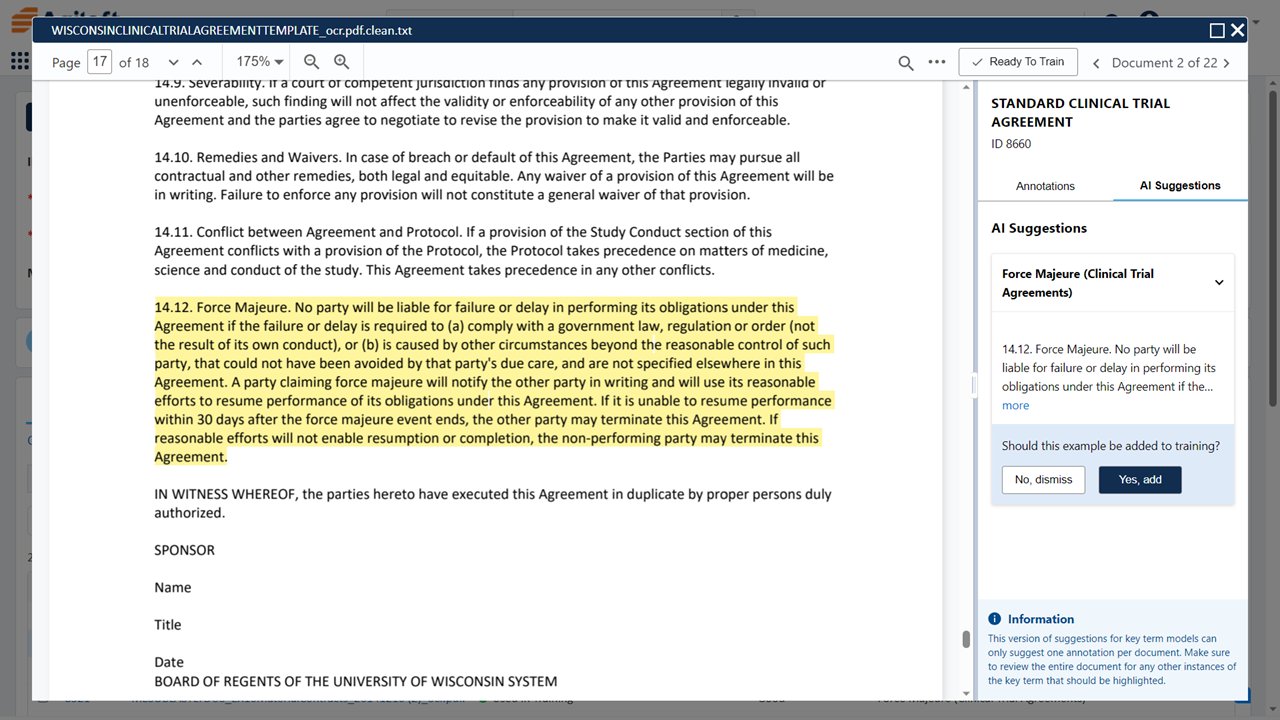One of the challenges of using artificial intelligence software for contract review is training the AI to conform to a company’s unique preferences regarding clauses and key terms. A new product from the contract lifecycle management company Agiloft aims to help companies overcome that challenge by enabling non-technical legal and business professionals to train its AI to identify key terms and clauses.
Called AI Trainer, the product provides a no-code training capability that enables non-technical users, including subject matter experts and legal professionals, to train AI models on the unique clauses and key terms specific to their organization or industry.
“No two contracts are quite alike, nor are any two organizations,” said Andy Wishart, Agiloft’s chief product officer. “That is why relying on pre-trained, generic AI models alone simply does not get the job done.”
AI Trainer, he said, “provides legal and contracting teams with an easy-to-use, self-service tool that helps them codify their expertise to enhance the automation of the contracting process.”
Learn more about Agiloft in the LawNext Legal Technology Directory.
Although most CLM products come with pre-trained AI models to identify standard clauses and data points within contracts, those pre-trained models do not provide all of the data-extraction points most organizations need, Wishart said.
“AI Trainer enables and empower legal teams to extract the data points that they need, and also to extract the data points and clauses that stakeholders within the business — within procurement, within sales, within HR — need to get out of their contract and processes,” Wishart said.
Creating Models
To use AI Trainer, a user starts by creating a training project for a particular clause to be extracted. To do that, the user uploads an initial set of no more than 20 documents containing variations on the preferred clause language. The user then tags and annotates each document to indicate the clauses that they want to use to train the AI model. As the user does this, the system learns so that by, say, the 16th document, it will suggest the part from which it is supposed to be learning.
Once the user has trained the model using that initial set of documents, the user publishes the model and it becomes available to use in review workflows.
During the training process, AI Trainer holds back about a quarter of the documents in the set to test the model and calculate its precision and recall. The published model shows the precision and recall numbers.
Multiple Use Cases
How would legal and business professionals use this within an organization? Several ways, says Wishart.
One workflow, Wishart said, would be to review legacy contracts sitting outside the CLM platform. “They can import those into Agiloft and apply that new AI model to identify, isolate, and extract those clauses so that those clauses could be reported on.”
Another use case would be to review incoming agreement drafts from outside parties. “They can utilize those artificial intelligence models that they’ve created through AI Trainer to identify the key terms and the clauses that are important to them, to then benchmark them against their standard template or clauses within their clause library.”
A third use case, he said, would be when there has been a change in a law or regulation impacting a company’s industry. “They then train an AI model to identify specific clauses within their documents, and they can then apply that to all of the documents within the repository to then find those documents that have that particular pattern or clause.”
Listen: Nicole Bradick and Andy Wishart on Why UI and UX Matter in Legal Tech Adoption.
A final use case would be to search for specific clauses or language within contracts, such as force majeure clauses or language containing specific data.
Agiloft’s model library can support multiple versions of models involving the same clause, such as for when a company use different indemnity language in different types of agreements. “You can have multiple models finding the same sort of legal concept, and within those models, there’s version control as well.”
Focus On Usability
In developing AI Trainer, Wishart said, a key focus was on creating something that would be easily usable by non-technical users directly within the Agiloft platform.
“Our focus is really on usability. I don’t want to take the user out of their core CLM environment into another system where they’re going to do that annotation. I want them to have the same user experience for the AI trainer capabilities and the AI capabilities as they do for the core CLM. So that unified experience is really critical in our opinion.”
AI Trainer is available to Agiloft customers immediately, but requires an additional purchase for the AI module.
Wishart said that the launch of AI Trainer is in keeping with the company’s broad vision to “build connected, intelligent, and autonomous contracting processes to help our customers unlock the value of their contract data, to ultimately accelerate decision making, and decision making that will ultimately then accelerate their business.”
The company has mapped out four stages in the execution of this vision:
- Digital and connected.
- Intelligent and optimized.
- Standardized and interoperable.
- Autonomous and self-governing.
The launch of AI Trainer falls within that intelligent and optimized phase, and builds on its launch last January of ConvoAI, a feature that lets users interact with contracts in a chat-like interface.
“We are introducing AI Trainer to ensure more organizations can use our best-of-breed AI to surface, analyze, and report on their contracts effectively. This AI Trainer empowers the very teams who are closest to the contracting process and gives them a way to train and individualize the systems they use to uncover and categorize key terms and clauses in their contracts.”
 Robert Ambrogi Blog
Robert Ambrogi Blog